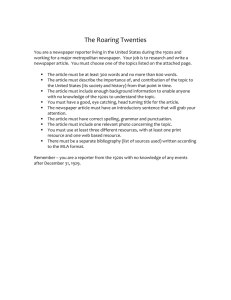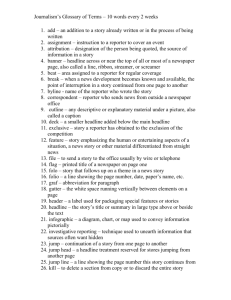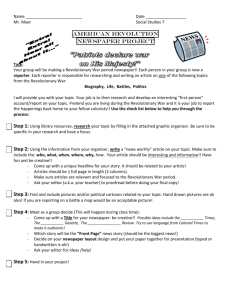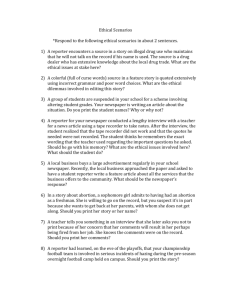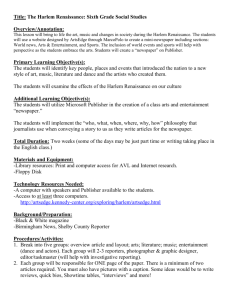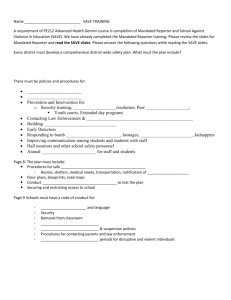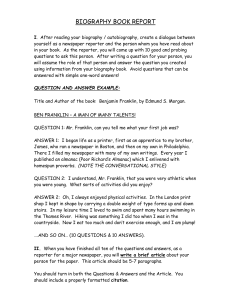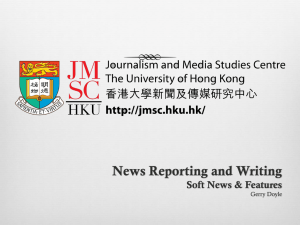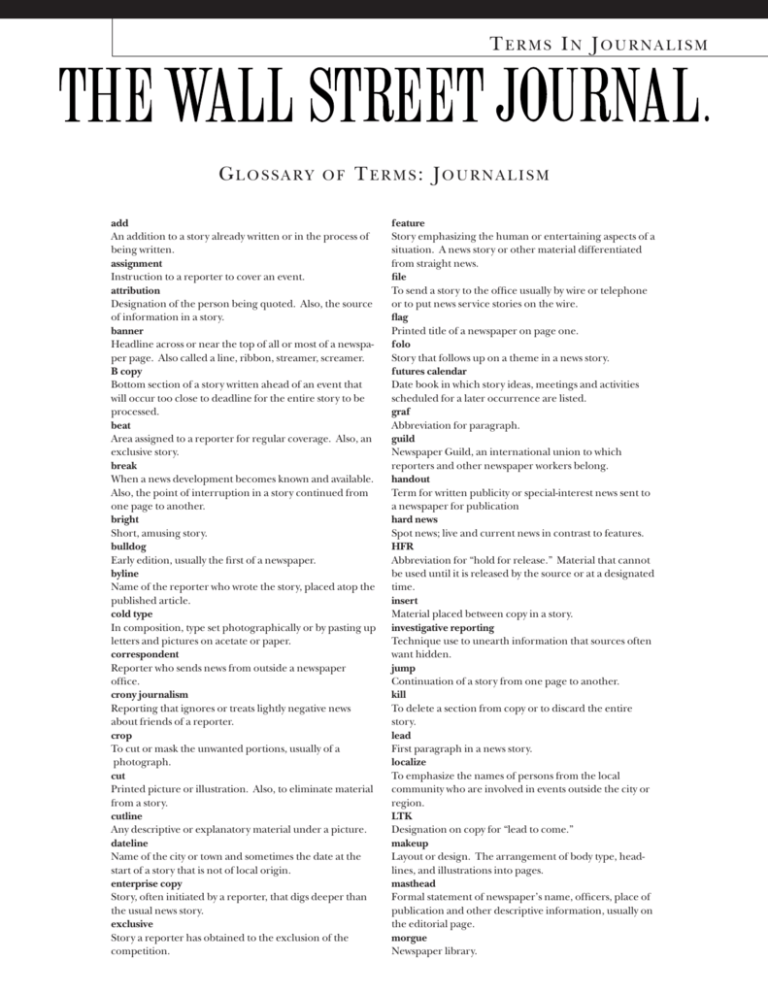
TERMS IN JOURNALISM
GLOSSARY
OF
TERMS: JOURNALISM
add
An addition to a story already written or in the process of
being written.
assignment
Instruction to a reporter to cover an event.
attribution
Designation of the person being quoted. Also, the source
of information in a story.
banner
Headline across or near the top of all or most of a newspaper page. Also called a line, ribbon, streamer, screamer.
B copy
Bottom section of a story written ahead of an event that
will occur too close to deadline for the entire story to be
processed.
beat
Area assigned to a reporter for regular coverage. Also, an
exclusive story.
break
When a news development becomes known and available.
Also, the point of interruption in a story continued from
one page to another.
bright
Short, amusing story.
bulldog
Early edition, usually the first of a newspaper.
byline
Name of the reporter who wrote the story, placed atop the
published article.
cold type
In composition, type set photographically or by pasting up
letters and pictures on acetate or paper.
correspondent
Reporter who sends news from outside a newspaper
office.
crony journalism
Reporting that ignores or treats lightly negative news
about friends of a reporter.
crop
To cut or mask the unwanted portions, usually of a
photograph.
cut
Printed picture or illustration. Also, to eliminate material
from a story.
cutline
Any descriptive or explanatory material under a picture.
dateline
Name of the city or town and sometimes the date at the
start of a story that is not of local origin.
enterprise copy
Story, often initiated by a reporter, that digs deeper than
the usual news story.
exclusive
Story a reporter has obtained to the exclusion of the
competition.
feature
Story emphasizing the human or entertaining aspects of a
situation. A news story or other material differentiated
from straight news.
file
To send a story to the office usually by wire or telephone
or to put news service stories on the wire.
flag
Printed title of a newspaper on page one.
folo
Story that follows up on a theme in a news story.
futures calendar
Date book in which story ideas, meetings and activities
scheduled for a later occurrence are listed.
graf
Abbreviation for paragraph.
guild
Newspaper Guild, an international union to which
reporters and other newspaper workers belong.
handout
Term for written publicity or special-interest news sent to
a newspaper for publication
hard news
Spot news; live and current news in contrast to features.
HFR
Abbreviation for “hold for release.” Material that cannot
be used until it is released by the source or at a designated
time.
insert
Material placed between copy in a story.
investigative reporting
Technique use to unearth information that sources often
want hidden.
jump
Continuation of a story from one page to another.
kill
To delete a section from copy or to discard the entire
story.
lead
First paragraph in a news story.
localize
To emphasize the names of persons from the local
community who are involved in events outside the city or
region.
LTK
Designation on copy for “lead to come.”
makeup
Layout or design. The arrangement of body type, headlines, and illustrations into pages.
masthead
Formal statement of newspaper’s name, officers, place of
publication and other descriptive information, usually on
the editorial page.
morgue
Newspaper library.
TERMS IN JOURNALISM
news hole
Space in a newspaper allotted to news, illustrations and
other nonadvertising material.
off-the-record
Describes material offered the reporter in confidence. If
the reporter accepts the material with this understanding,
it cannot be used except as general background in a later
story.
op-ed page
Abbreviation for the page opposite the editorial page.
The page is frequently devoted to opinion columns and
related illustrations.
overnight
Story usually written late at night for the afternoon newspapers of the next day.
pool
Arrangement whereby limited numbers of reporters and
photographers are selected to represent all those assigned
to the story.
press release
Publicity handout, or a story given to the news media for
publication.
puff piece or puffery
Publicity story or a story that contains unwarranted
superlatives.
roundup
A story that joins two or more events with a common
theme, such as traffic accidents, weather, police reports.
rowback
A story that attempts to correct a previous story without
indicating that the prior story had been in error or without taking responsibility for the error.
running story
Event that develops and is covered over a period of time.
sell
Presentation a reporter makes to impress the editor with
the importance of his or her story.
shirttail
Short, related story added to the end of a longer one.
sidebar
Story that emphasizes and elaborates on one part of
another nearby story.
situation
Story that pulls together a continuing event for the reader
who may not have kept track as it unfolded.
slant
To write a story so as to influence the reader’s thinking.
source
Person, record, document or event that provides the
information for the story.
split page
Front page of an inside section.
stringer
Correspondent, not a regular staff member, who is paid by
the story or by the number of words written.
tight
Refers to a paper so crowded with ads that the news space
must be reduced.
tip
Information passed to a reporter, often in confidence.
verification
Determination of the truth of the material the reporter
gathers or is given.
wire services
Synonym for press associations, the Associated Press and
United Press International.
Broadcasting Terms
close-up
Shot of the face of the subject that dominated the frame
so that little background is visible.
cover shot
A long shot usually cut in at the beginning of a sequence
to establish place or location.
cue
A signal in a script or by word or gesture to begin or to
stop.
cutaway
Transition shot - usually short - from one theme to
another; used to avoid jump cut.
dissolve
Smooth fading of one picture for another.
FI or fade in
A scene that begins without full brilliance and gradually
assumes full brightness.
lead-in
Introductory statement to film or tape of actual event.
lead-out
Copy that comes immediately after tape of film of an
actuality.
long shot
Framing that takes in the scene of the event.
medium shot
Framing of one person from head to waist or of a small
group seated at a table.
montage
A series of brief shots to give a single impression or
communicate one idea.
outtakes
Scenes that are discarded for the final story.
panning or pan shot
Moving the camera from left to right or right to left.
remote
A taped or live broadcast from a location outside the
studio; also, the unit that originates such a broadcast.
segue
An uninterrupted transition from one sound to another;
a sound dissolve.
zooming
Use of a variable focus lens to take close-ups and wide
angle shots from a stationary position.
Source: News Reporting and Writing, by Melvin Mencher, The McGraw-Hill Companies, Inc., 1997
©1998 Dow Jones & Company, Inc. All rights reserved. This material may be reproduced for classroom use.
F98

